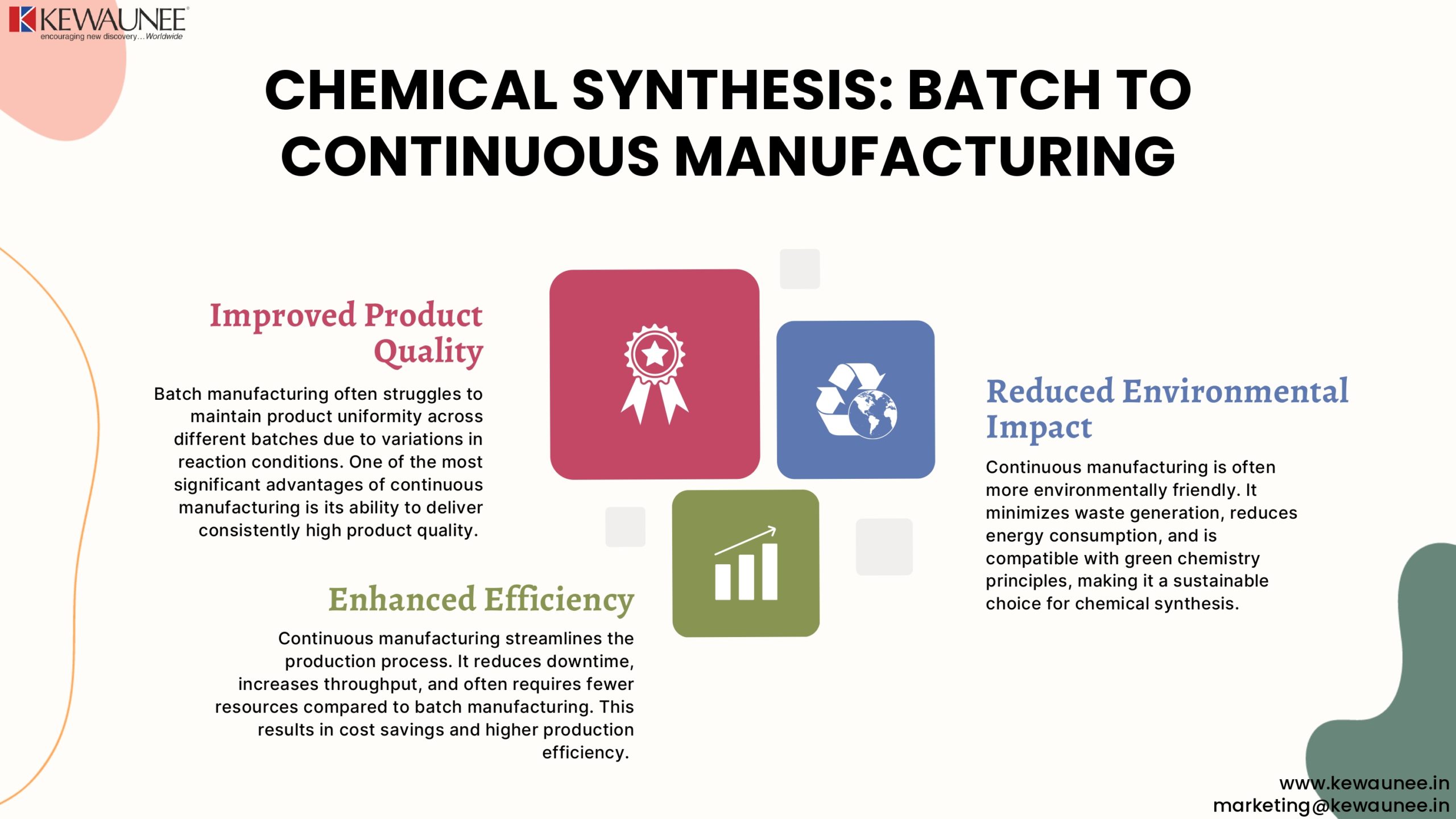Chemical Synthesis: Batch to Continuous Manufacturing
Chemical synthesis is a fundamental process in the production of various chemicals, from pharmaceuticals to specialty compounds. Traditionally, batch manufacturing has been the norm, but the industry is experiencing a significant shift towards continuous manufacturing.
In this blog, we explore the journey from batch to continuous manufacturing, the benefits it offers, and the excellence it brings to chemical synthesis.
1. Introduction
Chemical synthesis is the process of creating chemical compounds through a series of reactions. It’s a cornerstone of industries such as pharmaceuticals, chemicals, and materials science. The traditional approach, batch manufacturing, involves conducting reactions in discrete batches.
However, continuous manufacturing is emerging as a more efficient and precise alternative.
2. Batch Manufacturing
Batch manufacturing involves conducting chemical reactions in discrete, separate batches. Each batch typically consists of a fixed quantity of reactants, and the reactions occur in specialized vessels. While batch manufacturing has been the standard for decades, it has some limitations.
Batch manufacturing often leads to variations in product quality between batches, as it is challenging to replicate the exact conditions for each batch. It is also time-consuming and resource-intensive, with downtime between batches for cleaning and preparation. The reliance on fixed batch sizes can result in underutilized equipment during production.
3. Continuous Manufacturing: A Paradigm Shift
Continuous manufacturing represents a paradigm shift in chemical synthesis. Instead of conducting reactions in separate batches, it involves a continuous flow of reactants through a system of interconnected processes. This approach offers several advantages.
Continuous manufacturing minimizes batch-to-batch variability and leads to more consistent product quality. The ability to monitor reactions in real-time allows for immediate adjustments to maintain desired quality parameters. This also enhances the scalability of production, as processes can be easily adjusted to meet changing demands.
Continuous manufacturing significantly reduces downtime. In batch manufacturing, cleaning and setup between batches can account for a substantial portion of production time. In continuous manufacturing, there is no need for these interruptions, resulting in more efficient utilization of resources.
3.1. Improved Product Quality
One of the most significant advantages of continuous manufacturing is its ability to deliver consistently high product quality. Batch manufacturing often struggles to maintain product uniformity across different batches due to variations in reaction conditions.
Continuous manufacturing, with its real-time monitoring and control, ensures that the product quality remains within desired parameters.
3.2. Enhanced Efficiency
Continuous manufacturing streamlines the production process. It reduces downtime, increases throughput, and often requires fewer resources compared to batch manufacturing. This results in cost savings and higher production efficiency. It also allows for more agile and responsive production, as changes can be implemented on the fly.
3.3. Reduced Environmental Impact
Continuous manufacturing is often more environmentally friendly. It minimizes waste generation, reduces energy consumption, and is compatible with green chemistry principles, making it a sustainable choice for chemical synthesis. By reducing the need for large batches, it lowers the risk of excess waste production.
4. Challenges and Considerations
While continuous manufacturing offers numerous benefits, it’s not without challenges. Implementing continuous processes requires significant changes in equipment, infrastructure, and workflow. Manufacturers must carefully plan and execute the transition, which can be capital-intensive.
Continuous manufacturing also demands robust process control and automation systems to ensure the safety and quality of products. Furthermore, regulatory bodies are adapting to the shift, developing guidelines for continuous manufacturing processes. Manufacturers need to navigate the evolving regulatory landscape to ensure compliance.
5. Industry Applications
Continuous manufacturing has found applications in various industries. In pharmaceuticals, it’s being used for drug synthesis, particularly for high-volume products. The chemical industry is adopting continuous processes for the production of specialty and fine chemicals. The technology is also making strides in the petrochemical and materials sectors.
In pharmaceuticals, continuous manufacturing is ideal for high-demand products like generic drugs. The process allows for efficient production, rapid scale-up, and consistent quality. In the chemical industry, continuous manufacturing is particularly valuable for the production of specialty chemicals, which often require precise control over reaction conditions.
The technology is also proving advantageous in the petrochemical industry, where it is used for processes like distillation and separation. Additionally, continuous manufacturing is gaining traction in the materials sector, especially in the production of polymers, nanoparticles, and advanced materials.
6. Future Trends
The future of chemical synthesis is undeniably linked to continuous manufacturing. As technology and regulatory support for continuous processes continue to evolve, more chemical manufacturers will transition from batch to continuous manufacturing. This shift will likely lead to more innovation in process design and automation.
In the coming years, we can expect to see more compact and modular continuous manufacturing systems. These systems will allow for easier integration into existing facilities, making the transition more accessible for manufacturers. Additionally, advances in process analytical technology and real-time monitoring will further enhance the efficiency and reliability of continuous processes.
Summary
The journey from batch to continuous manufacturing in chemical synthesis is an exciting one. Continuous manufacturing offers superior product quality, enhanced efficiency, and reduced environmental impact. While challenges exist, the industry is embracing this transformation, and its applications are expanding.
As we look to the future, the excellence in chemical synthesis will be defined by the adoption of continuous manufacturing. This shift not only benefits the industry but also contributes to more sustainable and efficient chemical production. Continuous manufacturing is the future of chemical synthesis, and its potential is boundless.
The transition from batch to continuous manufacturing is not merely a shift in technology; it represents a fundamental change in how we approach chemical synthesis. It aligns with the principles of efficiency, sustainability, and quality, making it a driving force in the chemical industry’s pursuit of excellence.
Comments are closed.











